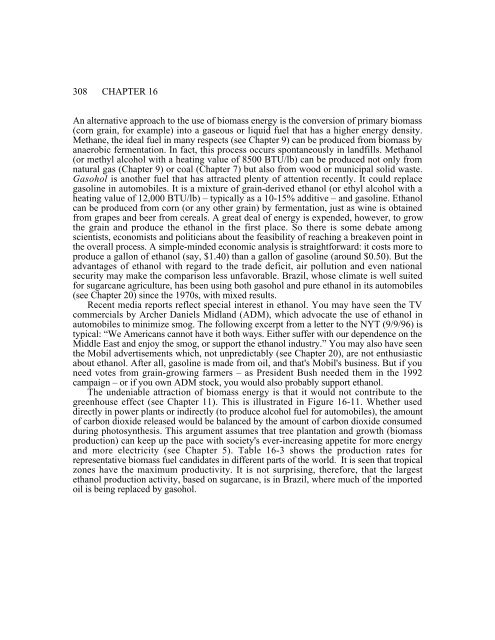Chapter 16 WATER, WIND, BIOMASS AND GEOTHERMAL ENERGY
Chapter 16 WATER, WIND, BIOMASS AND GEOTHERMAL ENERGY
Chapter 16 WATER, WIND, BIOMASS AND GEOTHERMAL ENERGY
You also want an ePaper? Increase the reach of your titles
YUMPU automatically turns print PDFs into web optimized ePapers that Google loves.
308 CHAPTER <strong>16</strong><br />
An alternative approach to the use of biomass energy is the conversion of primary biomass<br />
(corn grain, for example) into a gaseous or liquid fuel that has a higher energy density.<br />
Methane, the ideal fuel in many respects (see <strong>Chapter</strong> 9) can be produced from biomass by<br />
anaerobic fermentation. In fact, this process occurs spontaneously in landfills. Methanol<br />
(or methyl alcohol with a heating value of 8500 BTU/lb) can be produced not only from<br />
natural gas (<strong>Chapter</strong> 9) or coal (<strong>Chapter</strong> 7) but also from wood or municipal solid waste.<br />
Gasohol is another fuel that has attracted plenty of attention recently. It could replace<br />
gasoline in automobiles. It is a mixture of grain-derived ethanol (or ethyl alcohol with a<br />
heating value of 12,000 BTU/lb) – typically as a 10-15% additive – and gasoline. Ethanol<br />
can be produced from corn (or any other grain) by fermentation, just as wine is obtained<br />
from grapes and beer from cereals. A great deal of energy is expended, however, to grow<br />
the grain and produce the ethanol in the first place. So there is some debate among<br />
scientists, economists and politicians about the feasibility of reaching a breakeven point in<br />
the overall process. A simple-minded economic analysis is straightforward: it costs more to<br />
produce a gallon of ethanol (say, $1.40) than a gallon of gasoline (around $0.50). But the<br />
advantages of ethanol with regard to the trade deficit, air pollution and even national<br />
security may make the comparison less unfavorable. Brazil, whose climate is well suited<br />
for sugarcane agriculture, has been using both gasohol and pure ethanol in its automobiles<br />
(see <strong>Chapter</strong> 20) since the 1970s, with mixed results.<br />
Recent media reports reflect special interest in ethanol. You may have seen the TV<br />
commercials by Archer Daniels Midland (ADM), which advocate the use of ethanol in<br />
automobiles to minimize smog. The following excerpt from a letter to the NYT (9/9/96) is<br />
typical: “We Americans cannot have it both ways. Either suffer with our dependence on the<br />
Middle East and enjoy the smog, or support the ethanol industry.” You may also have seen<br />
the Mobil advertisements which, not unpredictably (see <strong>Chapter</strong> 20), are not enthusiastic<br />
about ethanol. After all, gasoline is made from oil, and that's Mobil's business. But if you<br />
need votes from grain-growing farmers – as President Bush needed them in the 1992<br />
campaign – or if you own ADM stock, you would also probably support ethanol.<br />
The undeniable attraction of biomass energy is that it would not contribute to the<br />
greenhouse effect (see <strong>Chapter</strong> 11). This is illustrated in Figure <strong>16</strong>-11. Whether used<br />
directly in power plants or indirectly (to produce alcohol fuel for automobiles), the amount<br />
of carbon dioxide released would be balanced by the amount of carbon dioxide consumed<br />
during photosynthesis. This argument assumes that tree plantation and growth (biomass<br />
production) can keep up the pace with society's ever-increasing appetite for more energy<br />
and more electricity (see <strong>Chapter</strong> 5). Table <strong>16</strong>-3 shows the production rates for<br />
representative biomass fuel candidates in different parts of the world. It is seen that tropical<br />
zones have the maximum productivity. It is not surprising, therefore, that the largest<br />
ethanol production activity, based on sugarcane, is in Brazil, where much of the imported<br />
oil is being replaced by gasohol.
















